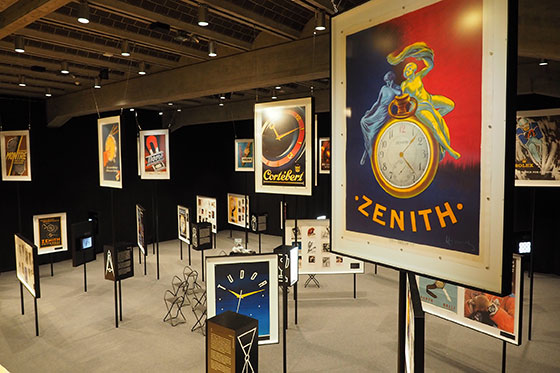
The Musée International de la Haute Horlogerie (MIH) in La Chaux-de-Fonds presents “L’heure pour tous, une montre pour chacun” (Time for all, a watch for everyone) a temporary exhibition entirely devoted to 20th century watch advertising. Immersed in the past, the public is invited to discover this exciting universe from six specific angles. To be visited until October 13th 2019.
After extensive research and synthesis, this exhibition – a first of its kind – is truly focused on the individual and the evolution of consumption across society. It is sparingly accompanied by texts so as to give pride of place to simple admiration. Large-format posters, engravings or even essays versions: the 230 or so elements composing the exhibition take viewers on a temporal journey in which watchmaking technique is set aside in favour of the various cultural uses of time.
A century of watch advertising
Operating in an increasingly competitive international market, the watch industry uses posters and advertisements to promote its products, often demonstrating conformity – sometimes originality – in the creation of its marketing designs.
Through the posters and advertisements which are the backbone of brand communication in the 20th century, the exhibition offers an original view of the economic, technological and cultural history of watchmaking, from the beginnings of the wristwatch to the technological revolution of the quartz watch.
A consumer-led approach
The parties behind the project – MIH and the Institute of History at the University of Neuchâtel – have demonstrated a crucial independence from the brands still active today. The exhibition is based on a study of more than 2500 visual documents. It explores the practices and topics in marketing which mark the transition from time for all to a watch for everyone through six subject pairs.
Time and astronomy
The watch is a tangible consumer good. But the thing that it measures – time – remains invisible and intangible. Illustrators have used a range of strategies to represent this concept. They developed themes relating to the stars and nature, the observation of which was the first and, for a long time, only way humans had of tracking the passage of time.
Accuracy and reliability
The hallmark of a quality watch, accuracy is the beacon of sales pitches presented by watch brands. Countless texts and slogans refer to accuracy. However, no specific image exists to clearly represent it. In the early 20th century, images would translate it via the execution of the drawing itself. From the 1950s, photography provided an additional means of creating realistic images. Accuracy came to be a part of daily life to such an extent that punctuality became a key factor in success in both professional and private scenarios.
Technology and features
Advertisements often focused specifically on the technical developments introduced for the wristwatch: on one hand, water resistance, shock resistance, antimagnetism; on the other, automatic winding. No longer just an accessory, the watch contributed to the new lifestyles of the second half of the 20th century, in which time seemed to become both more compact and more personal. It was no longer a case of selling time for all, but rather a watch for everyone.
Sport and performance
The practice of sport at a high level requires dynamism, rigorous discipline, and endurance, values with a particular appeal to watch brands. They also attract the type of people who embody the spirit of adventure, pushing themselves to extremes, and providing the consumer with an idealised reflection of the world. In times of war, the heroic figure of the soldier replaced the peace-time image of the sportsman.
Individuals and society
In advertising, the watch denotes a certain social status. For example, individuals shown in relation to others are denoted by means of their activities through stereotypical items, clothing and accessories. Until at least the late 1960s, the imagery in adverts perpetuated the dichotomy between the ladies’ jewellery watch and the masculine high-tech watch.
Production and distribution
From the late 19th century, manufacturers realised that they could profit from exploiting their own brand image showcasing their establishment through monumental architecture, a sign of their industrial power and their standing with the public. Images emerged which demonstrate a conflict between hyper-local production, symbolised by the imagery associated with Switzerland, and the global distribution of products.
230 original documents
Presenting the public with over 230 documents in the form of posters, adverts, original sketches, and commercials from cinema and television, taken from the MIH collections, other conservation institutions as well as private collections, the exhibition is also designed to give a panoramic view of the history of advertising, graphic design and the consumer society. All parts of the exhibition are presented in French, German, and English.
Publication
A book is also published to complement this exhibition. This richly-illustrated full-colour work comprises 268 pages; it is published by Editions Alphil-Presses Universitaires Suisses, as a limited edition of 1,000 copies in French. It provides the opportunity both to create a more lasting format for this exhibition, and to examine its subjects in more depth, thanks to the input of fifteen Swiss and international authors who are all specialists in their respective fields of watchmaking, advertising, consumer affairs, posters and photography.
As part of the “Sur le coup de midi” noon-time presentation on September 4th at 12.15pm, a free guided tour of the exhibition can be booked at any time.
Does creating an advertising poster sound like child’s play?
During the exhibition’s run, a workshop allowing both children and adults to design their own adverts is available. Everyone can test their advertising powers by composing their own poster using the elements encountered in the exhibition, which can then be submitted for potential consumers to admire by sharing it on the MIH Facebook and Instagram accounts #museeinternationaldhorlogerie, @musee_mih.
July 04, 2019


 News
News